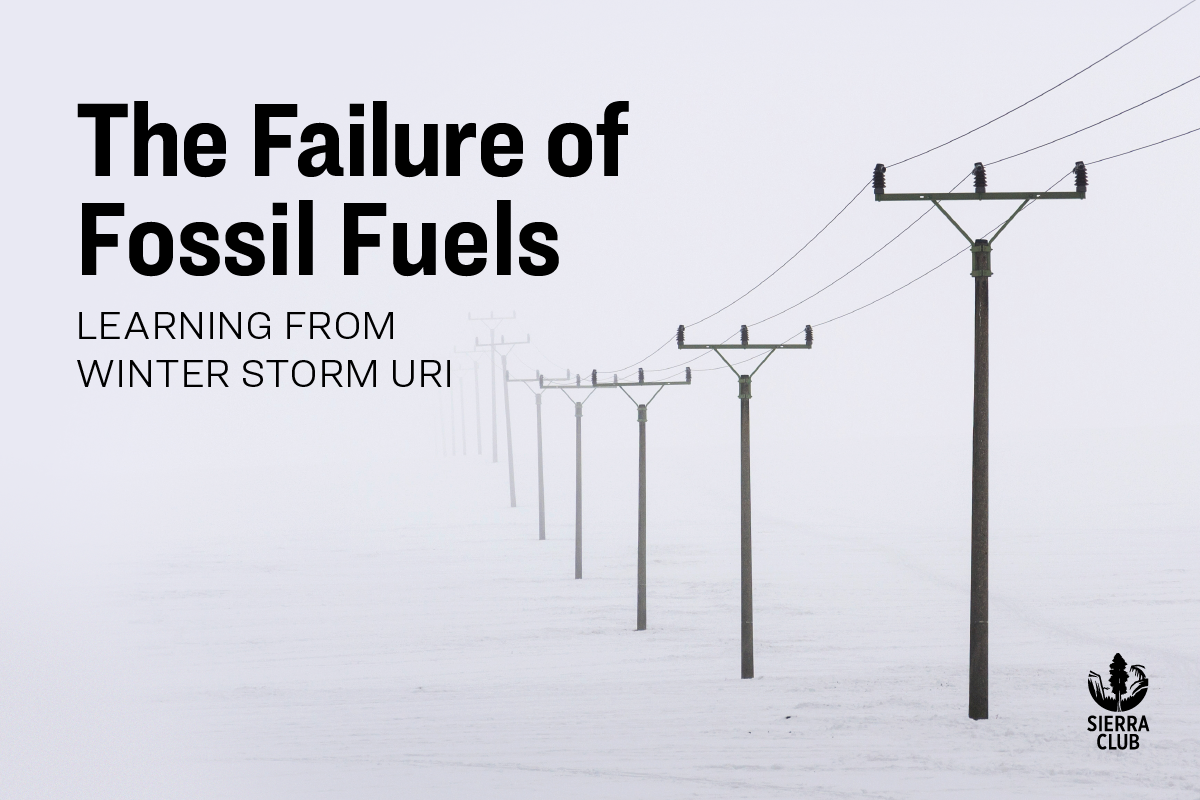We’re sharing the introduction from a new Sierra Club report, titled "The Failure of Fossil Fuels: Learning from Winter Storm Uri." Click here to read the full report.
For almost a week from February 13 through February 17, 2021, a winter ice storm–unofficially named Winter Storm Uri–slammed North America. The storm started in the Pacific Northwest, advanced across the southern United States and northern Mexico, and finally curved northward to hit the midwest and northeast United States and southeast Canada.
COMMUNITY VOICES - DR. CRAIG MORRIS NAZOR, AUSTIN, TEXAS"It was a shocking experience to live through. All you could do is sit there in the dark and think about the situation. There was no power and you didn’t want to be on the phone because there was only so much battery life. It gave you a lot of time to think about this planet." |
By the time Uri had dissipated, more than 170 million people across the United States had experienced some sort of winter weather alert, and almost ten million people in the United States and Mexico had lost power. The storm caused almost $200 billion dollars worth of damage, making it the most expensive natural disaster to ever hit the United States. It killed hundreds of people, making it the deadliest winter storm in almost 30 years. And while the state of Texas found that approximately 250 people died as a result of Uri, an independent analysis estimates as many as 700 people lost their lives due to the storm.
While many public officials were quick to blame the power outages on wind and solar, later analysis showed that the gas system was the primary source of the grid’s failures. The price of gas sailed to astronomical highs during the storm, forcing utilities and homeowners to incur massive debts, and prompting investigations into price gouging by pipeline operators. Millions of Americans will be paying higher gas bills for decades to come due to the gas system’s failures during this period.
COMMUNITY VOICES: JOE THE BARBER, TEXAS"We get reports that things are going to get bad. My sons and I start doing things like filling up the bathtub with water, pitchers that have lids—all the safety things were told to do. I didn’t sleep for three days."I remember being scared. The only time I was more scared was receiving mortar fire in Iraq. [During Winter Storm Uri, my] daughter was just over a year old. My sons are 8 and 13. I watched everyone sleep - doing everything I could for them."I had a legitimate mental breakdown toward the end. The first night was terrifying, feeling the temperature drop around us. Holding your children in your arms knowing that it’s only going to get colder." |
Climate change means extreme weather events—particularly extreme heat, extreme cold, and extremely powerful storms like Uri—are becoming increasingly common. And the cost of Winter Storm Uri—the damage to buildings and infrastructure, the people left without power for days or weeks, the people who lost their lives—could have been avoided with better planning, communication, and preparation at the local, state, and federal level.
In particular, this report identifies six key ways that public officials could address the failings that allowed Winter Storm Uri to cause such extensive damage:
-
Increase Energy Efficiency, to allow the same amount of electricity to go further;
-
Implement Demand Response, to intelligently shift when and where electricity is used;
-
Protect and Improve the Grid, to create a smarter energy system, ensure existing power generation can coexist with clean and distributed energy sources, and ensure that localized issues (such as outages due to extreme weather events) don't spread across the entire grid;
-
Increase Access to Clean Energy, to ensure that all communities can enjoy its benefits;
-
Foster More Public Input, to guarantee that individuals and communities (not just utilities and large corporations) have a voice in any and all regulatory decisions; and
-
Learn from Past Mistakes, so that the lessons learned from Winter Storm Uri—as well as from past extreme weather events like those in 2011 and 1989—are used to create a cleaner, more resilient grid.
Far from simple bad luck, Winter Storm Uri demonstrates the cost of climate inaction and an energy system that is overly dependent on gas. It offers a taste of what’s to come if regulators, policymakers, and public officials continue to ignore what is increasingly obvious: The climate crisis is real, it’s here, and—without real and substantive action—the cost of complacency will continue to rise.
COMMUNITY VOICES: DANIELA SILVA, AUSTIN, TEXAS"I volunteer with an organization called Community Resilience Trust, and when the storm first hit, we organized to get unhoused people into hotels, get them food and water, and get them mental health services. When there was no governmental support, we eventually had to extend our organizing to the city at large, getting food and water to people, transportation, rescuing them from places where they had no power and no water, getting diapers, baby formula, dog food to everyone who needed it." |
Want to learn more about the failures of fossil fuels? Click here to read the Sierra Club’s full report on Winter Storm Uri.
